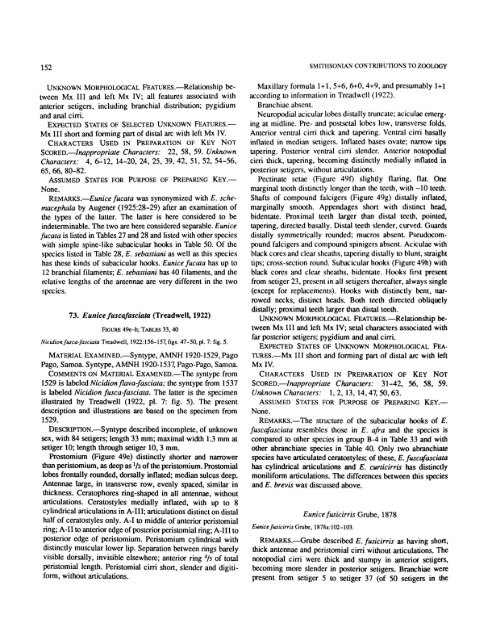A Review of the Genus Eunice - Smithsonian Institution Libraries
A Review of the Genus Eunice - Smithsonian Institution Libraries
A Review of the Genus Eunice - Smithsonian Institution Libraries
Create successful ePaper yourself
Turn your PDF publications into a flip-book with our unique Google optimized e-Paper software.
152 SMITHSONIAN CONTRIBUTIONS TO ZOOLOGY<br />
UNKNOWN MORPHOLOGICAL FEATURES.—Relationship between<br />
Mx III and left Mx IV; all features associated with<br />
anterior setigers, including branchial distribution; pygidium<br />
and anal cirri.<br />
EXPECTED STATES OF SELECTED UNKNOWN FEATURES.—<br />
Mx III short and forming part <strong>of</strong> distal arc with left Mx IV.<br />
CHARACTERS USED IN PREPARATION OF KEY NOT<br />
SCORED.—Inappropriate Characters: 22, 58, 59. Unknown<br />
Characters: 4, 6-12, 14-20, 24, 25, 39, 42, 51, 52, 54-56,<br />
65,66, 80-82.<br />
ASSUMED STATES FOR PURPOSE OF PREPARING KEY.—<br />
None.<br />
REMARKS.—<strong>Eunice</strong> fucata was synonymized with E. schemacephala<br />
by Augener (1925:28-29) after an examination <strong>of</strong><br />
<strong>the</strong> types <strong>of</strong> <strong>the</strong> latter. The latter is here considered to be<br />
indeterminable. The two are here considered separable. <strong>Eunice</strong><br />
fucata is listed in Tables 27 and 28 and listed with o<strong>the</strong>r species<br />
with simple spine-like subacicular hooks in Table 50. Of <strong>the</strong><br />
species listed in Table 28, E. sebastiani as well as this species<br />
has <strong>the</strong>se kinds <strong>of</strong> subacicular hooks. <strong>Eunice</strong> fucata has up to<br />
12 branchial filaments; E. sebastiani has 40 filaments, and <strong>the</strong><br />
relative lengths <strong>of</strong> <strong>the</strong> antennae are very different in <strong>the</strong> two<br />
species.<br />
73. <strong>Eunice</strong> fuscafasciata (Treadwell, 1922)<br />
FIGURE 49e-h; TABLES 33, 40<br />
Nicidionfusca-fasciata Treadwell. 1922:156-157, figs. 47-50. pi. 7: fig. 5.<br />
MATERIAL EXAMINED.—Syntype, AMNH 1920-1529, Pago<br />
Pago, Samoa. Syntype, AMNH 1920-1537, Pago-Pago, Samoa.<br />
COMMENTS ON MATERIAL EXAMINED.—The syntype from<br />
1529 is labeled Nicidionflava-fasciata; <strong>the</strong> syntype from 1537<br />
is labeled Nicidion fusca-fasciata. The latter is <strong>the</strong> specimen<br />
illustrated by Treadwell (1922, pi. 7: fig. 5). The present<br />
description and illustrations are based on <strong>the</strong> specimen from<br />
1529.<br />
DESCRIPTION.—Syntype described incomplete, <strong>of</strong> unknown<br />
sex, with 84 setigers; length 33 mm; maximal width 1.3 mm at<br />
setiger 10; length through setiger 10, 3 mm.<br />
Prostomium (Figure 49e) distinctly shorter and narrower<br />
than peristomium, as deep as 1 /2 <strong>of</strong> <strong>the</strong> peristomiurn. Prostomial<br />
lobes frontally rounded, dorsally inflated; median sulcus deep.<br />
Antennae large, in transverse row, evenly spaced, similar in<br />
thickness. Ceratophores ring-shaped in all antennae, without<br />
articulations. Ceratostyles medially inflated, with up to 8<br />
cylindrical articulations in A-III; articulations distinct on distal<br />
half <strong>of</strong> ceratostyles only. A-I to middle <strong>of</strong> anterior peristomial<br />
ring; A-I I to anterior edge <strong>of</strong> posterior peristomial ring; A-III to<br />
posterior edge <strong>of</strong> peristomium. Peristomium cylindrical with<br />
distinctly muscular lower lip. Separation between rings barely<br />
visible dorsally, invisible elsewhere; anterior ring 4 /5 <strong>of</strong> total<br />
peristomial length. Peristomial cirri short, slender and digitiform,<br />
without articulations.<br />
Maxillary formula 1+1, 5+6, 6+0, 4+9, and presumably 1+1<br />
according to information in Treadwell (1922).<br />
Branchiae absent.<br />
Neuropodial acicular lobes distally truncate; aciculae emerging<br />
at midline. Pre- and postsetal lobes low, transverse folds.<br />
Anterior ventral cirri thick and tapering. Ventral cirri basally<br />
inflated in median setigers. Inflated bases ovate; narrow tips<br />
tapering. Posterior ventral cirri slender. Anterior notopodial<br />
cirri thick, tapering, becoming distinctly medially inflated in<br />
posterior setigers, without articulations.<br />
Pectinate setae (Figure 490 slightly flaring, flat. One<br />
marginal tooth distinctly longer than <strong>the</strong> teeth, with -10 teeth.<br />
Shafts <strong>of</strong> compound falcigcrs (Figure 49g) distally inflated,<br />
marginally smooth. Appendages short with distinct head,<br />
bidentate. Proximal teeth larger than distal teeth, pointed,<br />
tapering, directed basally. Distal teeth slender, curved. Guards<br />
distally symmetrically rounded; mucros absent. Pseudocompound<br />
falcigcrs and compound spinigers absent. Aciculae with<br />
black cores and clear sheaths, tapering distally to blunt, straight<br />
tips; cross-section round. Subacicular hooks (Figure 49h) with<br />
black cores and clear sheaths, bidentate. Hooks first present<br />
from setiger 23, present in all setigers <strong>the</strong>reafter, always single<br />
(except for replacements). Hooks with distinctly bent, narrowed<br />
necks, distinct heads. Both teeth directed obliquely<br />
distally; proximal teeth larger than distal teeth.<br />
UNKNOWN MORPHOLOGICAL FEATURES.—Relationship between<br />
Mx III and left Mx IV; setal characters associated with<br />
far posterior setigers; pygidium and anal cirri.<br />
EXPECTED STATES OF UNKNOWN MORPHOLOGICAL FEA-<br />
TURES.—Mx III short and forming part <strong>of</strong> distal arc with left<br />
Mx IV.<br />
CHARACTERS USED IN PREPARATION OF KEY NOT<br />
SCORED.—Inappropriate Characters: 31-42, 56, 58, 59.<br />
Unknown Characters: 1, 2, 13, 14,47, 50, 63.<br />
ASSUMED STATES FOR PURPOSE OF PREPARING KEY.—<br />
None.<br />
REMARKS.—The structure <strong>of</strong> <strong>the</strong> subacicular hooks <strong>of</strong> £.<br />
fuscafasciata resembles those in E. afra and <strong>the</strong> species is<br />
compared to o<strong>the</strong>r species in group B-4 in Table 33 and with<br />
o<strong>the</strong>r abranchiate species in Table 40. Only two abranchiate<br />
species have articulated ceratostyles; <strong>of</strong> <strong>the</strong>se, E. fuscafasciata<br />
has cylindrical articulations and E. curticirris has distinctly<br />
moniliform articulations. The differences between this species<br />
and E. brevis was discussed above.<br />
<strong>Eunice</strong> fusicirris Grube, 1878<br />
<strong>Eunice</strong> fusicirris Grube, 1878a:102-103.<br />
REMARKS.—Grube described E. fusicirris as having short,<br />
thick antennae and peristomial cirri without articulations. The<br />
notopodial cirri were thick and stumpy in anterior setigers,<br />
becoming more slender in posterior setigers. Branchiae were<br />
present from setiger 5 to setiger 37 (<strong>of</strong> 50 setigers in <strong>the</strong>
















